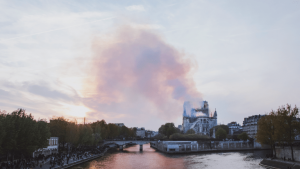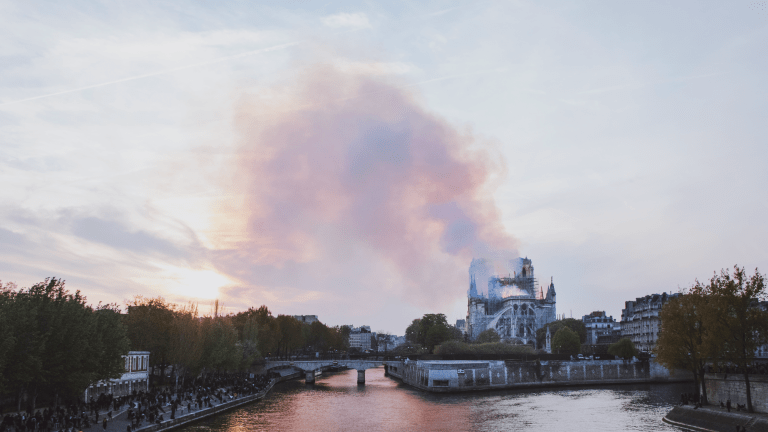
A UA art historian is part of a network of experts restoring a world treasure.
The Legend
Since its construction in 1163, Notre Dame Cathedral has been a symbol of culture, religion, art and French pride throughout the world. But on April 15, 2019, Notre Dame’s centuries-old story almost came to a close.
That evening a small fire broke out in the roof of the structure. This 800-year-old wooden roof, also known as “The Forest,” was already being renovated, and it was engulfed almost immediately. In just over an hour, the roof collapsed, bringing down the cathedral’s famed spire with it.
Over the next few days, Parisians and worldwide admirers alike wrestled with the loss of a significant portion of the Notre Dame Cathedral. Patrons promised millions in funds towards restoration as crews dug through the ashes, searching for anything that could be salvaged. But the structure itself would never be the same.
That is, unless restoration is guided by those who have spent their careers studying Notre Dame’s architecture, art and history.
The experts
Dr. Jennifer Feltman is one of those experts. Throughout her career as an art historian, the UA assistant professor has studied parts of Notre Dame, as well as other iconic cathedrals. She has joined with 200 art historians, scientists and academics as part of a grassroots group called “Scientifiques au service de la restauration de Notre-Dame de Paris” with one goal: to restore the Notre Dame Cathedral with sensitivity to its materials and history.
“We want to make sure that the restoration is something that doesn’t do damage to the building, erase parts of the past, or create problems for the future,” Feltman said.

The group of diverse researchers will work with government officials to further research Notre Dame’s history and architecture, collaborating with each other along the way. The group includes those studying the cultural and historical aspects of the monument, as well as scientists and engineers passionate about the restoration. Some of these scientists will study the makeup of materials in construction, the physics behind some of the cathedral’s gravity-defying features, and how climate change affected the building over time.
While working alongside governmental agencies as they develop a restoration plan, the research group will have space in France’s National Archives to work and collaborate, as well as a website in both English and French to share their research with each other and the public. These resources will make research more readily accessible and allow group members to ensure they are not performing the same research, in addition to building on the research of one another.
One of the biggest concerns held by many of the researchers is the debate on how to restore the monument. Throughout its history, Notre Dame has been renovated several times, the most intensive occurring in the 19thcentury, when the then-crumbling cathedral was given a new, state-of-the-art roof — the same one that collapsed during the fire.
“In restoration, there’s a bit of a negotiation of what matters to lots of different people,” Feltman said. “Sometimes, certain voices are allowed, and those are the only ones that are heard. But I think what’s happening in France is that they’re taking time to step back and think about what’s important and to hear from multiple voices.”
The Timeline
Although French President Emmanuel Macron originally said the cathedral could be restored in the next five years, the governmental organization in charge of restoration now realizes that it is likely going to take longer. Feltman’s previous research at Reims Cathedral in northeastern France has highlighted the long process of renovation and how even when the project seems complete, work could remain.
“Reims was bombed in 1914 during World War I and then restored into the 1940s,” Feltman said. “It took more than 30 years to complete. And, even then, the building still needs to be maintained.”
Feltman’s contributions to the Notre Dame research effort will be a study of its painted sculptures. Feltman will work with a group of other scientists and historians who are studying all aspects of the stones used in the construction of the cathedral. While the sculptures themselves were not damaged, the group will have unprecedented access to research and document everything about the material state of the sculptures in order to help with future preservation projects.
Over the next five years, the team will research the type of stone used, the evidence of paint, and evidence of previous restorations. The project will culminate in a symposium in Paris and a publication detailing the research, along with other groups’ research on the glass, wood, and other materials in Notre Dame.
The organization will serve the Centre des Monuments Historique, the government organization actually conducting the restoration, by providing knowledge to support the restoration of Notre Dame and preserve it in a historically and culturally sensitive manner.
“By studying the stones of spaces like Notre Dame for signs of material interaction with the building, we can get a sense of what was valuable to people in the past,” Feltman said. “This may help us to make decisions about what’s valuable in the future, in terms of what we preserve, what we build, and how we talk about those things.”
